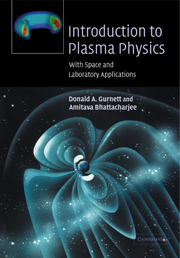Book contents
- Frontmatter
- Contents
- Preface
- 1 Introduction
- 2 Characteristic parameters of a plasma
- 3 Single particle motions
- 4 Waves in a cold plasma
- 5 Kinetic theory and the moment equations
- 6 Magnetohydrodynamics
- 7 Discontinuities and shock waves
- 8 Electrostatic waves in a hot unmagnetized plasma
- 9 Waves in a hot magnetized plasma
- 10 Non-linear effects
- 11 Collisional processes
- Appendix A Symbols
- Appendix B Vector differential operators
- Appendix C Vector calculus identities
- Index
- References
8 - Electrostatic waves in a hot unmagnetized plasma
Published online by Cambridge University Press: 05 June 2012
- Frontmatter
- Contents
- Preface
- 1 Introduction
- 2 Characteristic parameters of a plasma
- 3 Single particle motions
- 4 Waves in a cold plasma
- 5 Kinetic theory and the moment equations
- 6 Magnetohydrodynamics
- 7 Discontinuities and shock waves
- 8 Electrostatic waves in a hot unmagnetized plasma
- 9 Waves in a hot magnetized plasma
- 10 Non-linear effects
- 11 Collisional processes
- Appendix A Symbols
- Appendix B Vector differential operators
- Appendix C Vector calculus identities
- Index
- References
Summary
In this chapter we investigate the propagation of small amplitude waves in a hot unmagnetized plasma. Because of the shortcomings of the moment equations, the approach used is to solve the Vlasov equation directly using a linearization procedure similar to that used in the analysis of cold plasmas. Although both electromagnetic and electrostatic solutions exist, the discussion in this chapter is limited to solutions that are purely electrostatic, i.e., the electric field is derivable from the gradient of a potential, E = −∇Φ. Electromagnetic solutions are discussed in the next chapter.
From Faraday's law it is easily verified that electrostatic waves have no magnetic component. This greatly simplifies the Vlasov equation by eliminating the v × B force. For electrostatic waves, it is usually easier to solve for the potential rather than for the electric field. Therefore, in the following analysis, the electric field is replaced by E = −∇Φ, and the potential is calculated from Poisson's equation, ∇2Φ = −ρq/∊0.
The Vlasov approach
In an initial attempt to analyze the problem, we assume that normal modes of the form exp(−iωt) exist and represent them by using Fourier transforms, following the same basic procedure used in Chapter 4. This is the approach used by Vlasov [1945], who first considered this problem. As we will see, the Vlasov approach encounters a mathematical difficulty that can only be resolved by reformulating the problem in terms of Laplace transforms.
- Type
- Chapter
- Information
- Introduction to Plasma PhysicsWith Space and Laboratory Applications, pp. 281 - 340Publisher: Cambridge University PressPrint publication year: 2005

